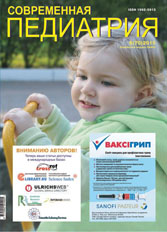Особенности патологических изменений у детей, рожденных с экстремально низкой массой тела
DOI:
https://doi.org/10.15574/SP.2015.70.86Ключевые слова:
недоношенность, экстремально низкая масса тела, головной мозг, магнитно-резонансная томографияАннотация
Проведен ретроспективный анализ историй болезней детей, рожденных с массою тела меньше 1000 г, который показал, что у младенцев с экстремально низкой массой тела при рождении можно предположить наличие врожденных аномалий головного мозга (нарушение нейрональной пролиферации и миграции, корковой организации). Традиционные методы нейровизуализации (ультразвуковое исследование, структурная МРТ головного мозга) являются субъективными и не позволяют прогнозировать степень неврологических нарушений в будущем.
Ключевые слова: недоношенность, экстремально низкая масса тела, головной мозг, магнитно-резонансная томография.
Библиографические ссылки
Kidokoro H, Anderson P, Doyle LW et al. 2014. Brain injury and altered brain growth in preterm infants: predictors and prognosis. Pediatrics. 134: 444—453. http://dx.doi.org/10.1542/peds.2013-2336; PMid:25070300
Rose J, Vassar R, Cahill-Rowley K et al. 2014. Brain microstructural development at near-term age in very-lowbirth-weight preterm infants: An atlas-based diffusion imaging study. Neuroimage. 1(86): 244—256. http://dx.doi.org/10.1016/j.neuroimage.2013.09.053; PMid:24091089 PMCid:PMC3985290
Fenton T. 2003. A new growth chart for preterm babies: Babson and Benda's chart updated with recent data and a new format. BMC Pediatrics. 3(13): 1—10.
Moore T, Hennessy E, Myles J et al. 2012. Neurological and development outcome in extremely preterm children born in Englend in 1995 and 2006: the EPICure studies. BMJ. 345: 7961—7974. http://dx.doi.org/10.1136/bmj.e7961; PMid:23212880 PMCid:PMC3514471
Plaisier A, Govaert P, Lequin M et al. 2013. Optimal timing of cerebral MRI in preterm infants to predict long-term neurodevelopmental outcome: a systematic review. Am J Neuroradiol. 2: 1—7.
Okabayashi S, Uchida K, Nakayama H et al. Periventricular leucomalacia (PVL) — like lesions in two neonatal cynomolgus monkeys (Macaca fascicularis). J Comp Pathol. 144: 204-211. http://dx.doi.org/10.1016/j.jcpa.2010.06.006; PMid:20705303
Dudink J, Pieterman K, Leemans A et al. 2015. Recent advancements in diffusion MRI forin investigating cortical development after preter birth — potential and pitfalls. Front Hum Neurosci. 8: 1—7. http://dx.doi.org/10.3389/fnhum.2014.01066; PMid:25653607 PMCid:PMC4301014
Pogribna U, Burson K, Lasky R et al. 2014. Role of diffusion tensor imaging as an independent predictor of cognitive and language development in extremely low-birth-weight infants. Am J Neuroradiol. 35(4): 790—796. http://dx.doi.org/10.3174/ajnr.A3725; PMid:24052505 PMCid:PMC3960368
Brouwer M, Kooij B, Haastert I et al. 2014. Sequential cranial ultrasound and cerebellar diffusion weighted imaging contribute to the early prognosis of neurodevelopmental outcome in preterm infants. PLOSS ONE. 9: 1—10. http://dx.doi.org/10.1371/journal.pone.0109556
Mathur A, Neil J, Inder T et al. 2010. Understanding brain injury and neurodevelopmental disabilities in the preterm infant: the evolving role of advanced MRI. Semin Perinatol. 34(1): 57—66. http://dx.doi.org/10.1053/j.semperi.2009.10.006; PMid:20109973 PMCid:PMC2864915
Volpe J. 2009. Brain injury in premature infants: a compex amalgam of destructive and development disturbances. Lancet. 8(1): 110—124. http://dx.doi.org/10.1016/S1474-4422(08)70294-1

